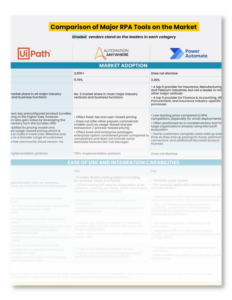In contrast to other traditional IT solutions, Robotic Process Automation (RPA) allows organizations to automate at a fraction of the cost and time previously encountered. RPA is non-intrusive in nature as it leverages your existing infrastructure without disrupting underlying systems, which would typically be much more difficult and expensive to replace. Imagine, for example, an ERP implementation…
Here are 7 key benefits of RPA and how it’s different from other technologies:
1. Accessible in price with significant cost reduction opportunities.
RPA offers relatively low licensing and implementation costs compared to its high-cost reduction value, as long as process automation candidates are chosen wisely. Organizations would typically start with “low-hanging fruit” processes where there’s a decent number of hours/FTEs associated with the activities being automated. Always remember that whether a process takes 10 people to do it or one part-time employee, both can have the same level of complexity and effort to automate. That’s why you want to focus first on processes that can give you the best ROI. To learn more about how RPA software pricing works for top RPA platforms like UiPath, click here.
2. Fast benefit realization.
70% of organizations achieve paybacks of less than 12 months from their RPA initiatives, according to a recent survey. A simple robot can be implemented in 2-3 weeks. Even though the financial business case is not the only consideration for implementing RPA, it’s a very critical one for many organizations.
3. No disruption to underlying systems.
RPA is non-intrusive software that runs on top of existing IT infrastructure and requires no system integration or APIs – only user access.
4. Led by the business, with support from IT.
The business leads most of the RPA initiatives since many automation opportunities fall within specific business functions: Finance & Accounting, HR, Customer Service, Operations, etc. Internal IT teams are typically overburdened with other projects and many organizations have chosen to rely heavily on RPA implementation partners for the development and ongoing support of the robots, involving IT in a very limited way (e.g., providing system access and infrastructure). To learn more about the skills and roles required to implement RPA, download our guide to building a winning RPA Center of Excellence (COE).
5. Highly scalable & flexible.
RPA automation workflows are easy to adjust and scale up or down as your organization evolves. Additional bots can be deployed easily and quickly as your transactional volumes go up, as opposed to human workers.
6. Better customer service & revenue enablement.
Robots will never make data entry mistakes and will always process transactions faster than a person. Improved accuracy and faster cycle times and response times translate into improved customer experience and retention. The same concept can apply to your vendors! To see some examples of how RPA has not only helped reduce costs but enabled more revenue to the business, check out this blog.
7. Happier employees & increased strategic focus.
Once you’ve automated manual, repetitive processes, your employees can be redeployed to more strategic, value-added activities to support your business growth – driving higher retention and engagement.
According to a Forbes study that found that 92% of companies saw improved employee satisfaction after implementing RPA.
RPA is no longer a technology for Fortune 500 organizations. In the last five years, it has been made accessible to companies of all sizes. Even start-ups and midmarket organizations can leverage this tool to better compete with larger players in their industry, allowing them to be more agile and flexible internally and with their customers.
A key to the success of your RPA program will be relying on a strong implementation partner like Auxis that can help you shortcut the key lessons learned and pitfalls that many companies go through in the early stages. To schedule a consultation with our RPA experts to discuss how we can help you in your automation journey, click here.



